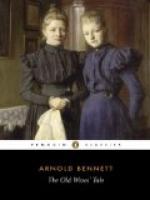CHAPTER VII
BRICKS AND MORTAR
I
In the summer of that year the occurrence of a white rash of posters on hoardings and on certain houses and shops, was symptomatic of organic change in the town. The posters were iterations of a mysterious announcement and summons, which began with the august words: “By Order of the Trustees of the late William Clews Mericarp, Esq.” Mericarp had been a considerable owner of property in Bursley. After a prolonged residence at Southport, he had died, at the age of eighty-two, leaving his property behind. For sixty years he had been a name, not a figure; and the news of his death, which was assuredly an event, incited the burgesses to gossip, for they had come to regard him as one of the invisible immortals. Constance was shocked, though she had never seen Mericarp. ("Everybody dies nowadays!” she thought.) He owned the Baines-Povey shop, and also Mr. Critchlow’s shop. Constance knew not how often her father and, later, her husband, had renewed the lease of those premises that were now hers; but from her earliest recollections rose a vague memory of her father talking to her mother about ‘Mericarp’s rent,’ which was and always had been a hundred a year. Mericarp had earned the reputation of being ‘a good landlord.’ Constance said sadly: “We shall never have another as good!” When a lawyer’s clerk called and asked her to permit the exhibition of a poster in each of her shop-windows, she had misgivings for the future; she was worried; she decided that she would determine the lease next year, so as to be on the safe side; but immediately afterwards she decided that she could decide nothing.
The posters continued: “To be sold by auction, at the Tiger Hotel at six-thirty for seven o’clock precisely.” What six-thirty had to do with seven o’clock precisely no one knew. Then, after stating the name and credentials of the auctioneer, the posters at length arrived at the objects to be sold: “All those freehold messuages and shops and copyhold tenements namely.” Houses were never sold by auction in Bursley. At moments of auction burgesses were reminded that the erections they lived in were not houses, as they had falsely supposed, but messuages. Having got as far as ‘namely’ the posters ruled a line and began afresh: “Lot I. All that extensive and commodious shop and messuage with the offices and appurtenances thereto belonging situate and being No. 4 St. Luke’s Square in the parish of Bursley in the County of Stafford and at present in the occupation of Mrs. Constance Povey widow under a lease expiring in September 1889.” Thus clearly asserting that all Constance’s shop was for sale, its whole entirety, and not a fraction or slice of it merely, the posters proceeded: “Lot 2. All that extensive and commodious shop and messuage with the offices and appurtenances thereto belonging




